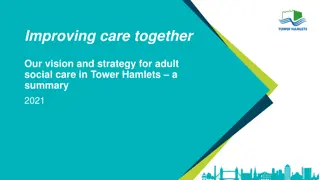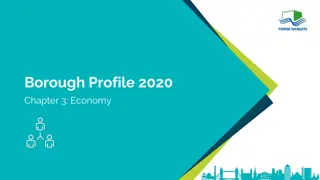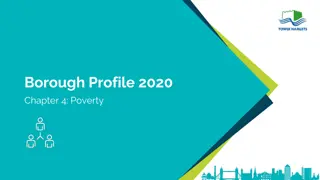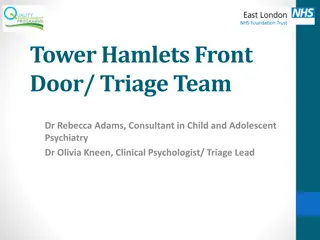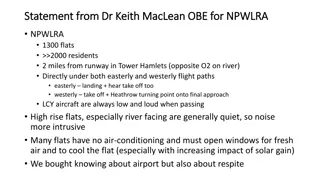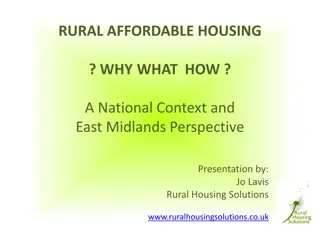Tower Hamlets Housing Profile and Challenges
The housing situation in Tower Hamlets presents significant challenges, with a high number of households on the waiting list and in temporary accommodation. Homelessness disproportionately affects younger residents, with specific reasons cited such as the end of shorthold tenancy and domestic violence. The borough has a high percentage of BME households on the housing register, particularly of Bangladeshi heritage. Despite efforts to address housing needs, Tower Hamlets remains one of the most deprived areas in England in terms of housing barriers and services.
Download Presentation

Please find below an Image/Link to download the presentation.
The content on the website is provided AS IS for your information and personal use only. It may not be sold, licensed, or shared on other websites without obtaining consent from the author.If you encounter any issues during the download, it is possible that the publisher has removed the file from their server.
You are allowed to download the files provided on this website for personal or commercial use, subject to the condition that they are used lawfully. All files are the property of their respective owners.
The content on the website is provided AS IS for your information and personal use only. It may not be sold, licensed, or shared on other websites without obtaining consent from the author.
E N D
Presentation Transcript
Borough Profile 2020 Chapter 5: Housing
Summary The council has the 7thhighest waiting list nationally. There are 18,808 households on the council s housing waiting list. BME households account for 78% of all households on the housing register. In March 2019, there were 2,529 households in temporary accommodation, of which half are placed in accommodation outside of the borough. In 2017/18 568 homeless decisions. Homelessness disproportionately affects younger residents in the borough, with 83% of homeless acceptances in 2017/18 from those aged 16 -44. In 2018/19 the council approved 250 applications for the Disability Facilities Grant. In 2018/19 375 people were seen rough sleeping in the borough. People seen rough sleeping are predominately male (88%) and are UK nationals (66%) Estimates published by MHCLG show that 39% of housing in Tower Hamlets is now privately rented. Around 12,000 additional homes were built in the borough between 2015 and 2018. Tower Hamlets has one of the highest housing targets in London and is expected to accommodate an additional 54,000 homes between 2016/17 and 2030/31.
Housing Deprivation Tower Hamlets was the 24th most deprived local authority area in England on the Indices of Multiple Deprivation Barriers to Housing and Services Domain in 2019, having been the 4th most deprived area in 2015 2015 2019
Housing Need (1) Housing waiting list In 2019 there were 19,826 households on the Tower Hamlets housing register . This is the third highest waiting list in London after Newham and Lambeth and the 8th highest nationally. Around 40 percent of households on the housing waiting list are living in over-crowded conditions. BME households make up 78 percent of households on the housing register which includes 60 percent on the housing register record as Asian, predominately of Bangladeshi heritage. Temporary accommodation Tower Hamlets has the 7th highest number of households in London, living in temporary accommodation. In March 2019, there were 2,529 households living in temporary accommodation, of which half (1,260 households) are in accommodation outside of the borough.
Housing Need (2) Homelessness In 2017/18 Tower Hamlets made 568 homeless decisions, 9% higher than the number of decisions made in 2016/17. Main Reasons For Homlessness in Tower Hamlets 2017-2018 End of shorthold tenancy 93 Homelessness disproportionately affects younger age groups with 83% of homelessness acceptances in 2017/18 from those aged 16 44. Domestic Violence 63 Friends/Family no longer able to accommodate 78 Overall, 75% of all acceptances are from households with dependent children, and 45% are from female lone parents with dependent children. Parents no longer able to accommodate 110 Source: MHCLG, Live Tables on Homelessness, 2017-2018 0 20 40 60 80 100 120
Housing Need (3) Supported housing Our Supporting People Commissioning Strategy sets out local needs and the programme to support residents learning difficulties and disabilities, residents with mental and substance misuse problems, lone parents families, families afflicted by domestic violence, as well as refugees, ex-offenders and vulnerable young people. There are currently 5,023 supported housing units in the borough. Known gaps in provision include: Lack of appropriate supported housing options for residents with learning disabilities, mental health issues and aging residents, and Lack of suitable housing options and provision for those leaving the care system, for teenage parents, and for young people at risk due to homelessness. Disabled households The housing needs survey carried as part of the 2014 Strategic Housing Market Assessment(SHMA) estimated there are 20,293 households that contain at least one household member with a disability or limiting long term illness; 1.7% of households said that they have a support need; 10.5% of households said that their home had been adapted to meet the needs of a household member with a disability. In 2018/19 the council approved 250 applications from landlords, tenants, leaseholders and owner-occupiers for Disability Facilities Grant programme carried out works to their homes. Older people housing Our analysis shows that compared to the national and regional average, 65% of our residents aged 50 and over live in social housing.
Housing Need (4) Rough sleepers In 2018/19 there were 375 people seen rough sleeping in the borough. Support needs among rough sleepers, Tower Hamlets, 2017/18 and 2018/19- % of rough sleepers with support needs Tower Hamlets has the 7th highest number of rough sleepers in the Capital. People seen rough sleeping are predominately male, 81% and UK nationals (66%). 63 63 62 59 50 47 By ethnicity just under four in ten (39%) were White British, 15.5% were from the White Other group, 2 % were Bangladeshi and 8% were Black African. The age profile of people seen rough sleeping in Tower Hamlets is younger compared to than that for London. Approximately 40% of people seen rough sleeping in Tower Hamlets are aged 36-45 compared to 32% in London. 11 9 Alcohol Drugs Mental Helath None of these needs Rough Sleeping in London (CHAIN reports), Greater London Authority 2017/18 2018/19
Housing Tenure There has been significant change in the tenure profile of the borough s housing stock over the last two decades. Office for National Statistics research outputs based on MHCLG dwelling stock data and the Annual Population Survey estimate that 39% of the housing in the borough was privately rented in 2017. At its peak 86% of the local housing stock was council owned, according to MHCLG estimates this has had fallen to 9% by 2018 with a further 26% managed by registered providers/housing associations. In Tower Hamlets older residents, those aged 50 and over are more likely to be living in social housing, whilst young adults under 34 are more likely to live in private rented accommodation.
Housing Stock Tower Hamlets has experienced the fastest growth in its housing stock in the country over the last decade with the number of dwellings increasing from 197,010 in 2011 to 120,020 in 2018, an increase of 24%. Between 2015 and 2018 almost 12,000 additional homes have been built in the borough. After Waltham Forest (42%) and Barking and Dagenham (36%) Tower Hamlets (30%) has delivered the 3rd highest proportion of affordable homes in the Capital. Around 63% of second homes in London are in 5 London boroughs: Kensington and Chelsea 8,850 homes Camden 7,120 homes Tower Hamlets 6,160 homes Barnet 3,660 homes Westminster 3,190 homes In 2018, 82 (23%) of London s existing 360 tall buildings (20+ storeys) were in Tower Hamlets. 71 of these buildings were primarily residential, comprising more than 20,400 homes. 6 out of 25 tall buildings completed in 2018 in London were in Tower Hamlets. There were a further 84 tall buildings in the pipeline (proposed/under construction). Short Term lets are increasingly common for both tourism and work, including both whole properties and individual rooms within properties.
Housing Delivery Between 2016/17 and 2030/31 Tower Hamlets is expected to accommodate an additional 54,000 homes. Housing delivery will be focused in: City Fringe/Tech City Isle of Dogs/South Poplar Lower Lea Valley Nearly half of these new homes (49%) will be in the Isle of Dogs (Canary Wharf, Blackwall & Cubitt Town wards).
Housing Affordability In September 2019, the average house price in Tower Hamlets was 481,000, just above the London average of 468,330 and twice the national average of 240,000. Between September 2014 and March 2019, private sector rents increased by 17% and are now the 9th highest of all the London Boroughs. The average rent in Tower Hamlets was 1,647 compared to 695 nationally. In 2019 the average earnings for residents in the borough is 42,602 higher than the London average of 36,797 and the England average of 30,661.








